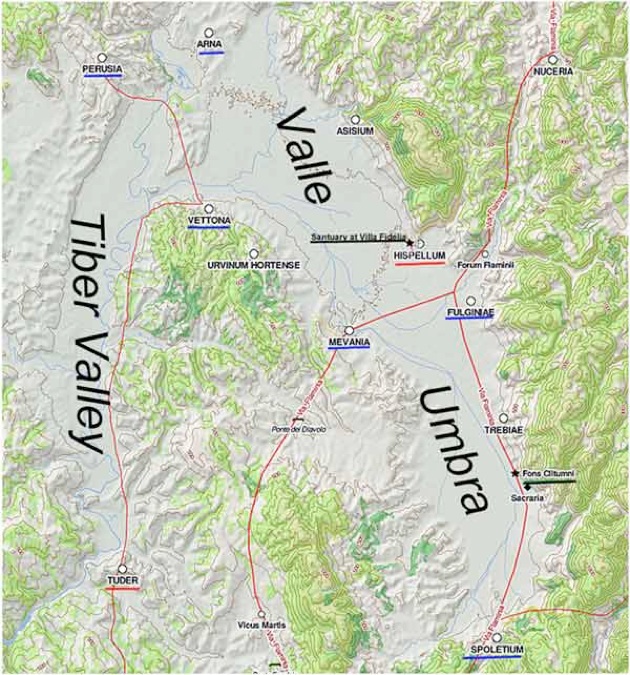
Colonisation in Umbria in ca. 43 - 27 BC (adapted from the Digital Atlas of the Roman Empire)
Underlined in red (Hispellum and Todi): colonies founded by Octavian
Underlined in black (sanctuaries at Villa Fidelia and at the fons Clitumnus): ceded to the colony at Hispellum
Underlined in blue (Mevania, Asisium, Spoletium, Perusia, Arna, Vettona, Fulginia): centres affected by veteran settlement
In his account of the Augustan Sixth Region, Pliny the Elder noted that:
-
“... at the present day , we find two colonies ... in the interior [of peninsular Italy: [those at] Hispellum [modern Spello] ;and Tuder [modern Todi]”, (’Natural History’, 3: 19).
These colonies were founded in the aftermath of a a momentous meeting at Bononia (Bologna) in October 43 BC, at which Octavian (the adopted son of Julius Caesar) agreed with his former enemies, Mark Antony and Lepidus, on the formation of a triumvirate (dictatorship of three), an allegedly temporary arrangement for the government of Italy after Caesar’s murder. According to Appian recorded that, while they were still at Bononia:
-
“To encourage the army with the expectation of booty, [the triumvirs] promised [the soldiers], beside other gifts, 18 cities of Italy as colonies - cities that excelled in wealth and in the splendour of their estates and houses - which were to be divided among them (land, buildings, and all), just as though they had been captured from an enemy in war. The most renowned among these were: Capua; Rhegium; Venusia; Beneventum; Nuceria [in Campania]; Ariminum; and Vibo. Thus were the most beautiful parts of Italy marked out for the soldiers”, (‘Civil Wars’, 4: 3).
Cassius and Brutus were duly defeated at Philippi in 42 BC, after which, as Josiah Osgood (referenced below, at p. 159) observed:
-
“[Mark] Antony remained to settle affairs in the east, while Octavian hurried to a terrified Italy to distribute the land promised to Caesar’s veterans.”
Colonia Julia Hispellum
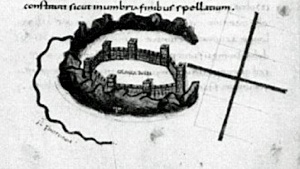
Colonia Julia Hispellum, in Hyginus’ treatise on the establishment of ‘limites’ (boundaries),
from the paper by Oswald Dilke (referenced below, p. 419)
t
Laurence Keppie (referenced below, at p. 63) deduced the probable identities of all 18 of the Italian towns that the triumvirs had selected for veteran settlement: crucially for our purposes, his list included Hispellum (Spello). Keppie’s deduction in this case (at p. 178) was based on this autobiographical passage by the poet Propertius:
-
“Ancient Umbria gave birth to [me], at a noble hearth ... Where misty Mevania [Bevagna] wets the open plain, [where] the summer waters of the Umbrian lake steam, and [where] the wall of climbing Asisium [Assisi] towers from the summit, that wall made more famous by [my] genius. Not of an age to gather them, [I nevertheless] gathered [my] father’s bones, and [was myself] forced to find a meaner home, since, though many bullocks ploughed [my] fields, the merciless measuring-rod [of the Roman land surveyors] stole [my] wealth of land”, (‘Elegies’, 4: 1a).
From this passage, it seems that Asisium and perhaps Mevania, had suffered land confiscations, almost certainly in order to facilitare the deduction of the colony at nearby Hispellum. Lines from another of Propertius’ elegies give further details of his family’s suffering, and suggest a date for them:
-
“You ask ... Tullus, ... of what people am I? If our country’s graves at Perusia are known to you, Italy’s graveyard in darkest times, when Rome’s citizens dealt in war - [when], to my special sorrow, Etruscan dust ... allowed my kinsman’s limbs to be scattered [and] covered his wretched bones with no scrap of soil - know that Umbria, rich in fertile ground, bore me, where it touches there on the plain below [Perusia]”, (‘Elegies’, 1: 22). We might reasonably assume that these two tragic episodes in the life of the young Propertius had occurred at about the same time. Thus, as Laurence Keppie summarised (at p. 178):
-
“The Propertii of Asisium, recently deprived of a substantial part of their property (or under threat of deprivation) are easily envisaged as supporters of Lucius Antonius , rallying to his aid at nearby Perusia [during the Perusine War (41-40 BC)].”
He therefore concluded (at pp. 178-9) that:
-
“... the misfortunes of the Propertii seem best associated with the foundation of the [colony of Hispellum], an event that may [therefore] be confidently placed in 41 BC, [shortly before the start of the war].”
The earliest epigraphic evidence for the colony at Hispellum was provided by a now-lost inscription (CIL XI 5291, discussed below), which was apparently was found in the 19th century in ‘the ruins of ancient Arna’ and which dates to some time in the last three decades of the 1st century BC. It read:
fin(es) col(oniae) / Hispell(atis).
As we shall see, this colony was probably formed in the tumultuous period that followed the murder of Julius Caesar in 44 BC and was probably considerably enhanced after the victory of Octavian (the adopted son of Julius Caesar) over Mark Antony at the Battle of Actium in 31 BC.
Why was Hispellum Chosen for Colonisation ?
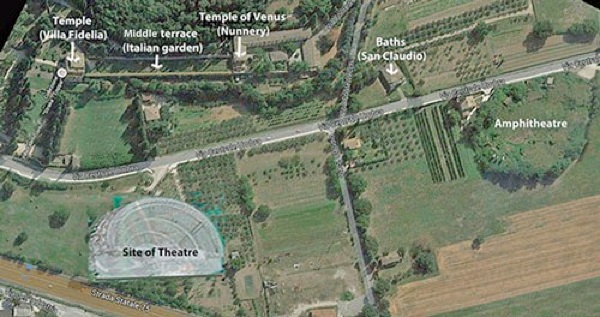
Aerial view of the site of the sanctuary at Villa Fidelia, Spello, as monumentalised after Octavian’s victory at Antium
The likely plan of the now-demolished theatre is overlaid at the lower left
As Enrico Zuddas and Maria Carla Spadoni (referenced below, at pp. 57-8) pointed out:
-
“If Appian was correct in stating [in the passage quoted above] that the cities chosen for deduction [in 43 BC] were among the most prosperous and civilised of Italy, then [Hispellum seems to have been an exception]. ... The choice of [Hispellum] for the foundation of a colony seems therefore to have been dictated by other considerations: certainly by its centrality in the [Valle Umbra] but, above all, by the presence in its immediate vicinity of the federal sanctuary of Umbria, on the site of the present Villa Fidelia” (my translation).
Zuddas and Spadoni certainly raise an important question, albeit that, while the sanctuary here was clearly important, there is no hard evidence that it was, or ever had been, the federal sanctuary of Umbria. John Scheid (referenced below, 2005, at p. 182) was more cautious in this respect: when he placed the colonisation of Hispellum in the context of Octavian’s policy of religious restoration:
-
“In order that Italy [as well as Rome] benefitted from Octavian’s restorations, he paid attention to old and important Italic sanctuaries. For instance, ... [inter alia], he founded a colony at Hispellum, possibly an old federal sanctuary, and [also] gave [the new colony] responsibility for the famous sanctuary of Clitumnus [which had belonged to Spoletium].”
He expanded on his hypothesis in a later paper (referenced below, 2006, at p. 82):
-
“It should first be noted that, according to the archaeologists, the large sanctuary at [Villa Fidelia] ... could have succeeded an important supra-regional sanctuary of the Umbrians. [As in other cases], the reason for the foundation of a colony [at the relatively small urban centre here might thus have been] the presence of [this putative] renowned Italic supra-regional cult site. Unfortunately, all we know for certain at the moment is that this sanctuary had a supra-regional role in the [4th century AD, as evidenced by the Rescript of Constantine]. ... The place was clearly very important. But, what interests us more particularly was another decision of Octavian, which [was probably] taken in the same context: he gave the famous sanctuary at the source of the Clitumnus to the Hispellates. ... In other words, he confiscated this cult site from Spoletium, [modern Spoleto], which had owned it since the deduction of the colony [there in 241 BC]; and perhaps he similarly confiscated a supra-regional sanctuary at Villa Fidelia [from Mevania, modern Bevagna] to make a [new] colony and an urban centre” (my translation).
But this all begs another question: if, Octavian wanted control over the sanctuary at Villa Fidelia and if it then belonged to Mevania, why did he not simply colonise Mevania, a city that might well have numbered among among “the most prosperous and civilised of Italy” at this time? I think that the answer might lie with the fact that Mevania had an influential patron.
An Influential Patron of Mevania?
A now-lost funerary inscription (CIL XI 5029, 50-20 BC from Massiccio [outside Mevania ??] commemorated Titus Resius, who had been a significant benefactor of Mevania. The inscription read:
T(ito) Resio T(iti) f(ilio) Aim(ilia) / leg(ato) pro pr(aetore)
locus sepulturae ipsi / posterisq(ue) eius ob plurima
erga suos municipes / merita publice datus
This identifies Resius as a member of the Aemilia tribe, which suggests that he came from Mevania, and also as legatus pro praetore (see below). The inscription recorded that he had been given a burial site (presumably at Massiccio) for himself and his descendants in appreciation of his public services to the people of the municipium. Maria Carla Spadoni and Lucio Benedetti (referenced below, at p. 249 and note 139), following Emilio Gabba (referenced below, at p. 103), suggested that Resius might well have delivered these services to the municipium in 41 BC, when it faced the threat of land confiscations for the new colony. In fact, it might be possible to be more specific, since Resius held the post of legatus pro praetore. This usually referred to a military officer who governed a Roman province with the powers of a praetor but, as Joseph Solodow (referenced below, at p. 147) pointed out:
-
“... ‘praetores’ could [also] refer to those magistrates ... who were granted imperium for the purpose of confiscating land and distributing it to veterans. It is known, for instance, that, under Caesar, Quintus Valerius Orca carried out this task as legatus pro praetore.”
The relevant information comes from two letters (‘Letters to Friends’, 13: 4 and 5, translated by David Shackelton Bailey, referenced below at pp.73-9) that Cicero wrote to Orca, whom he addressed as legatus pro praetore, when he was engaged in settling Caesar’s veterans at the Etruscan city of Volaterrae (Volterra) in 45-4 BC. Ronald Syme (referenced below, 1955, at p. 68) suggested that, in view of the fact that Resius subsequently held the same title as Orca:
-
“The man from Mevania may have earned the gratitude of his fellow citizens for things done (or not done) when [he was] a land commissioner in the period between [Julius] Caesar and Caesar Augustus [i.e. 44-27 BC]”.
If so, then these services were most probably rendered in the context of the veteran settlement in the Valle Umbra in 41 BC.
I would like to suggest that Mevania had, in fact, been selected for colonisation, but that Resius was persuaded (or managed to persuade his superiors) to settle for the confiscation of:
-
✴the vicus at nearby Hispellum, which would provide a good site for the urban centre of the new colony and was also close to tracts of good agricultural land that could be confiscated from Mevania and Asisium;
-
✴the sanctuary at Villa Fidelia; and
-
✴for good measure, the sanctuary of Clitumnus at the Fonti del Clitunno (as discussed further below).
This would be sufficient for a prosperous colony that could, in addition, be placed at the heart of the religious life of the Valle Umbra.
Second Wave of Colonisation ?
Simone Sisani (referenced below, 2012, at pp. 435-6) suggested that there is a body of evidence for the hypothesis that:
-
“... the triumviral colony at Hispellum was refounded in the early Augustan age [i.e. in ca. 27 BC], probably as part of a [wider] programme of colonial reinforcement to accommodate the mass of disarmed veterans following the Battle of Actium [in 31 BC] and the victorious end of the conflict [between Octavian and Mark Antony]” (my translation).
As discussed below, this evidence comprised:
-
✴the fact that the impressive walls of the urban centre of the Hispellum were almost certainly built at about this time; and
-
✴epigraphic evidence (discussed in a later section) for the settlement of veterans at Hispellum who had probably retired only after the Battle of Actium.
City Walls of Hispellum
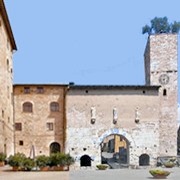
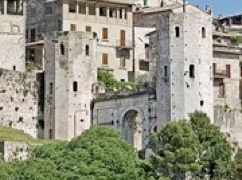
Porta Consolare (ca. 41 BC) Porta Venere (ca. 27 BC)
Paul Fontaine (referenced below, at p. 257-9) established that the gates and walls of Hispellum appear to have been built in two phases:
-
✴Porta Consolare, on the decumanus maximus, was probably built in ca. 40 BC as a formal entrance to its originally unwalled urban centre of the new colony; and
-
✴the walls of this urban centre (of which substantial stretches survive) apparently belong to a later phase of construction. Fontaine suggested that:
-
“An attractive hypothesis is that this second phase was executed at the time of Augustus’ restoration of Via Flaminia in 27 BC [see below]” (my translation).
Linda Baiolini (referenced below, at p. 90), who accepted Fontaine’s dating of the walls, observed that it was supported by the fact that Porta Venere, at the other end of the decumanus maximus:
-
“... is indisputably related, not only to the Porta Palatina at Turin (28 BC), but also to the new typology of gates flanked by towers in a series of monuments in the Cisalpina that are generally (albeit not unanimously) dated to the early Augustan period” (my translation).
Paul Fontaine (referenced below, at p. 260-1) observed that the function of these new walls:
-
“... have the appearance of a prestige project with an essentially symbolic meaning: to use a felicitous expression of P. A. Févrie, it is 'the walls that make the city', and it is in this capacity that [the walls of Hispellum] seem to find their fundamental justification. This concept, which sees the ramparts and the city as an autonomous entity, is profoundly rooted in the Roman mentality: more than one text testifies to it, and one finds an excellent illustration in the case of Hispellum, where the walls symbolise the colony [itself]” (my translation).
Thus the walls were built at a time when they were certainly not needed not needed for defence: rather, they were meant to demonstrate the high status of the colony, quite possibly because it was in the process of expansion in order to accommodate some of the men who had secured the extraordinarily important victory at Actium.
Political Climate after Naulochus (36 BC) and Actium (31 BC)
The people of the Valle Umbra had seen the worst in the young triumvir Octavian in 41-40 BC, at the time of the Perusine War and the land confiscations that facilitated the deduction of the colony of Hispellum. As Laurence Keppie (referenced below, at p. 61) observed:
-
“The method of acquiring land [for veteran settlement at this time] was simple and callous: wholesale confiscation from owners [who were] mostly innocent of any disaffection or disloyalty [to Rome or to the newly-elected triumvirs]. With good reason could the dispossessed complain of the injustice of their plight.”
However, Josiah Osgood (referenced below, at pp. 323-4) analysed the new image that Octavian projected after his victory over Sextus Pompeius at Naulochus in 36 BC, which represented:
-
“... the most significant of several shifts in [his] public image during the triumvirate. ... Now, he would try to ... [repair his image among] the segment of [Italian] society that [he] had antagonised terribly with land confiscations and dissatisfied still further with [the famine that had resulted from] the war against Sextus ... [He now wanted] to show that there would be an end to chaos, that ... property rights did matter. ... This time, ... there was no need for dispossessed landowners [in Italy] to take up arms [to prevent confiscation]: to settle the 20,000 time-served men who had been fighting at least since the battle of Mutina [of 43 BC], Octavian .... [now] used public land ... and some plots abandoned in the colonies of 41 BC, ... [while] other veterans were sent [outside Italy], especially to Gaul, a province in his control.”
Colonia Julia Fida Tuder (at modern Todi, in southern Umbria) might have been established at this time: as Laurence Keppie (referenced below, at p. 71) observed:
-
“... Tuder ... received veterans of legio XXXXI at an unspecified date: on Dio’s testimony, its founder members could well have qualified for release after Naulochus. One centurian of the legion had served a centurio classicus, perhaps at that [naval] battle.”
Enrico Zuddas (referenced below) presented evidence for enclaves of this colony some distance to the north, and outlined (at p. 126) the motivation for this pattern of settlement:
-
“A new colony needed fertile and cultivated land; since the land around the present town of Todi is predominantly hilly and suitable for only forestry or the grazing of animals, agricultural land that could be allocated to veterans had to come from elsewhere in the Tiber valley. Consequently, it is legitimate to assume that the colony had also been assigned land in the southern and eastern part of Lake Trasimeno, which legally belonged to Perusia and Chiusi” (my translation).
In the new political climate that Osgood described, we might reasonably assume that this was largely public land, and that much of it had belonged to Perusia until the confiscations that had followed the Perusine War.
The political climate must have been even more benign after Octavian’s victory at Actium, when he emerged as the undisputed ruler of the Roman Empire. The promised end to the civil wars, which had been somewhat prematurely declared after Naulochus, was now a reality. Italy could now look forward to the fruits of his victories in a period of peace, security and prosperity: the acceptance of what was, in effect, a dictatorship must have seemed a small price to pay. In his biography, Augustus recalled that:
-
“To the municipal towns, I paid money for the lands which I assigned to soldiers in my own 4th consulship [in 30 BC] and afterwards in the consulship of Marcus Crassus and Gnaeus Lentulus, the augur [in 14 BC]. The sum that I paid for estates in Italy was about 600,000,000 sesterces, and the amount that I paid for lands in the provinces was about 260,000,000. I was the first and only one to do this of all those who up to my time had settled colonies of soldiers in Italy or in the provinces”, (’Res Gestae Divi Augusti’, 3:16).
Laurence Keppie (referenced below, at p. 76) suggested that most of the 600,000,000 sesterces that Augustus spent on land in Italy would have related to veteran settlement in 30 BC (while the smaller sum that he paid for land in the provinces would have related to settlement there in 14 BC).
Restoration of Via Flaminia (27 BC)
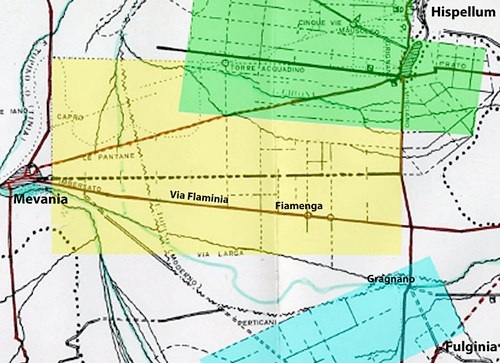
Pertiche of Hispellum, Mevania and Fulginia
Adapted from Manconi et al. (referenced below, 1996), with kind permission of the authors
In his autobiography, Augustus recorded that:
-
“As consul for the seventh time [in 27 BC], I [restored] the Via Flaminia from [Rome] to Ariminum [modern Rimini, on the Adriatic coast]...”, (‘Res Gestae Divi Augusti’, 4:20).
This project included the construction of the famous Ponte di Augusto at Narnia (modern Narni), at the start of the western branch of the road that ran through Mevania: almost 600 years later, Procopius recorded that:
-
“This bridge [at Narnia] was built by Caesar Augustus in early times, and is a very noteworthy sight; for its arches are the highest of any known to us”, (’History of the Wars’, 5:17).
The combination of the restoration of the western branch of the road and the construction of the impressive bridge at the start of it presumably brought increased prosperity to both Mevania and the expanding colony at Hispellum.
An indication of the source of finance for this restoration comes from Suetonius, who noted that, when Augustus was restoring Via Flaminia, he also:
-
“... assigned the [restoration of the other main Roman] highways to others who had been honoured with triumphs, asking them to use their prize-money in paving them”, (’Life of Augustus’, 30).
We might therefore reasonably assume that Augustus used part of his receipts from his triple triumph of 29 BC (for his victories in Dalmatia, at Actium and in Egypt) to finance his restoration of the Via Flaminia. There is also surviving evidence for the political significance of the project: according to Cassius Dio:
-
“[Via Flaminia] was finished promptly ... and statues of Augustus were accordingly erected on arches on [the Milvian Bridge, outside Rome] and at Ariminum”, (‘Roman History’, 53:22).
Carsten Hjort Lange (referenced below, at pp. 161-2 and note 46) cited coins that suggest that these were:
-
“ ... ‘triumphal arches’, in as much as they were connected to triumphs, even if their purpose was to honour Augustus for road building. ... [They] operated as triumphal markers in Rome and Italy, glorifying the victory at Actium.”
Frances Hickson (referenced below, at p. 134) made a similar point:
-
“Both the repair [of Via Flaminia] and the arches [at its ends] were part of a republican tradition by which many triumphatores built or restored public buildings and works in fulfilment of vows and as a means of memorialising their victories.”
It seems likely that the stretches of the restored Via Flaminia in the Valle Umbra were similarly articulated to ensure that the victory at Actium would not be forgotten.
As I mentioned above, a funerary inscription (CIL XI 5275) from Fiamenga on Via Flaminia (marked on the plan above), which is now in the Museo Archeologico at Palazzo Trinci, Foligno, commemorates Cnaeus Decimius Bibulus, an evocatus of legio XIII who had probably been settled at Hispellum after Actium. This might indicate a colonial enclave here: however, it is alternatively possible that this site was in a corridor of land that belonged to Hispellum and connected it to Via Flaminia. In this context, it is interesting to note that, in the so-called Rescript of Constantine (CIL XI 5265, ca. 335 AD), the Emperor Constantine referred to:
-
“... your city, which is now called Hispellum and which you report borders immediately on Via Flaminia ... ” (from the translation by Noel Lenski, referenced below, at pp. 118-9).
It is thus possible that the putative second wave of settlement at Hispellum included the purchase of a strip of land that connected the urban centre of the colony to the recently-restored Via Flaminia.
Walls of Hispellum (again)
As discussed above, the construction of the walls around the urban centre of Hispellum in ca. 27 BC seems to have been a ‘prestige project’, intended to underline the elevated status of the expanding colony. Paul Fontaine (referenced below, at p. 260-1) observed that:
-
“... with reference to Fano and Nîmes, where inscriptions attest to the fact that their walls were built by Augustus, we might ask ourselves whether the walls of Spello were not a manifestation of imperial euergetism. Their refined construction presupposes the expenditure of considerable financial resources, and Augustus’ [earlier] gift to the [colony] of the sanctuary of Clitumnus is indicative of his special solicitude towards it” (my translation).
This does not, of course, provide hard evidence of imperial involvement in the construction of the walls. However, it seems to me that Fontaine is probably correct and that, like the restoration of Via Flaminia, the building of these walls was probably financed from the spoils of war.
Characteristics of Colonisation
Lemonia Tribe
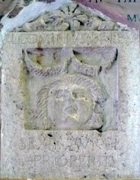
L(ucius) Cominius L(uci) f(ilius) Lem(onia)
This is probably provides the earliest evidence for the tribal assignation of Hispellum, which, as Simone Sisani (referenced below, 2012, at p. 432 and note 117) pointed out, was quite distinct from that of its neighbours (including Mevania, which was assigned to the Aemilia).
As Enrico Zuddas and Maria Carla Spadoni (referenced below, at p. 57) pointed out:
-
“ ... at least nine secure epigraphic records [of this tribal assignation have been] found in the city or in its immediate surroundings. [However, none of them can be assigned to the period] before the triumviral age” (my translation).
They therefore pointed out that:
-
“... on the basis of current knowledge, one cannot exclude a priori that the [assignation of Hispellum to the Lemonia] was linked to the formation of the colony” (my translation).
In other words, before colonisation, Hispellum could have belonged to Mevania and thus been assigned to the Aemilia Whether or not this was the case, it certainly belonged to the Lemonia after colonisation.
Gens Grania and Other Campanian Colonists
As we shall see below, the Granii belonged to what became one of the most prominent families settled in the new colony, establishing itself at Hispellum itself and at colonial enclaves at Fulginia (Foligno), Perusia (Perugia) and Tifernum Tiberinum (Città di Castello). The earliest surviving record of them at Hispellum is from a now-lost inscription (CIL XI 5264) from the nunnery of the Suore Francescane Piccolo San Damiano, which stands on the site of a temple in the sanctuary at Villa Fidelia (marked ‘nunnery on the aerial photograph above). The inscription read:
M. Granius, Sex. Lollius IIvir(i)/ quinq(uennales)
signum et basim veneris
ex d(ecreto) d(ecurionum) f(aciunda)
c(uraverunt) eidemq(ue) prob(averunt)
It commemorated the duoviri quinquennales Marcus Granius and Sextus Lollius, who had commissioned a statue to Venus, following a decree of the decurians of the colony. Paolo Braconi (referenced below, at p. 40) suggested that Granius and Lollius had been among the first duoviri of the new colony, and this suggestion was supported, for example, by Simone Sisani (referenced below, 2012, at p. 435), who cited archeological evidence that placed this temple project (discussed further below) in the triumviral period. The inscription did not record the tribe of either Granius or Lollius, although, as we shall see, a descendant of the former was assigned to the Lemonia.
According to Maria Carla Spadoni (referenced below, 2010, pp. 16-7), the gens Grania was not originally from Umbria:
-
“It came from Campania (Puteoli or Allifae), and had perhaps arrived [at Hispellum] only at the time of the deduction of the colony” (my translation).
She referred (at p. 38) to other families that moved from Campania to Umbria at about this time. For example:
-
✴Two men from the gens Atilia held the post of quattuorvir in Perusia in the period after the Perusine War but before the city was ‘restored’ in some way by Augustus, (probably in the period 1-14 AD): at that point, it was named Perusia Augusta and exchanged its quattuorviri for duoviri (see below).
-
✴Two brothers from the gens Caesia, who became quattuorviri quinquennales at Asisium, also built the so-called temple of Minerva there in the early imperial period (as discussed below). Their family subsequently built up substantial landholdings at Asisium itself and also at Mevania, Forum Flaminii and Spoletium.
We know from Cassius Dio that Octavian had recruited Caesarian veterans in Campania for his private army in 44 BC, as he prepared to confront Mark Antony. Specifically:
-
“... he ... went to Campania and collected a large number of men, chiefly from Capua, because the people there had received their land and city from his father [Julius Caesar], whom he said he was avenging. He made them many promises and gave them ... 2,000 sesterces apiece. From these men was constituted the corps of evocati, which one might translate as the ‘recalled’ because, after having ended their military service, they were recalled to it again”, (’Roman History’, (45: 12).
Maria Carla Spadoni concluded (at p. 40) he relative frequency with which men from Campania appeared in the Valle Umbra after the Perusine War:
-
“... was the result of the [recruiting] activity that Salvidienus Rufus undertook in Campania on behalf of Octavian in 44 BC, ... above all directed at Caesar’s veterans ... We can reasonably assume that Octavian placed some of these Campanian supporters in key positions in the new colony at Hispellum and, more generally, that they became crucial pawns on the Umbrian chessboard in the period after the [Perusine] war” (my translation).
Territory Assigned to Hispellum
A treatise by ‘Hyginus II’ on ‘limites’ (boundaries), which was incorporated into the writings of the Roman land surveyors, contains a section on Hispellum that has been translated as follows:
-
“Men of old, because of the danger of sudden outbreaks of war, were not satisfied with building walls around their cities, but also chose sites on rough and rocky high ground, where the best defence lay in the very topography of the site. Very many of the precipitous areas adjacent to these cities were not suitable for limites because of the difficulties of the terrain, and were left outside the centuriation [land division], either to provide woods for the community or, if they were barren, to lie unoccupied:
-
-the territory of neighbouring communities was granted to these cities, so that they could have an extent of land appropriate for a colony; and
-
-the decumanus maximus and kardo maximus [of the new settlements] were drawn on the best land;
-
as, for example, in Umbria, in the territory of Hispellum” (translated by Brian Campbell, referenced below, at p. 143).
The syntax of this passage has been much-debated, and there is no consensus as to how much of it applied specifically to Hispellum. However:
-
✴as discussed below, it certainly seems that land at a number of neighbouring communities was settled by triumviral veterans, either at the time of the original deduction of the colony at Hispellum or during a second wave of veteran settlement in the region about a decade later; and
-
✴it is also true that the decumanus maximus and kardo maximus of Hispellum intersected on the fertile plain below Hispellum, as depicted in the diagram at the top of the page, which came from the treatise of ‘Hyginus II’.
Mevania
I suggested above that the vicus of Hispellum and the adjacent sanctuary had probably belonged to Mevania before the deduction of the colony and that the transfer of this land for colonisation was probably part of a compromise effected by Titus Resius that had averted the colonisation of Mevania itself. It is possible that Mevania also suffered other confiscations at this time: for example, Enrico Zuddas and Maria Carla Spadoni (referenced below, pp. 61-2) discussed four inscriptions (CIL XI: 4907, 5118, 5275 and 5286, discussed below) that constituted:
-
“[...a group] from the area around Mevania, which ... [suggest that the city was] surrounded by ‘hotspots’ of the Lemonia” (my translation).
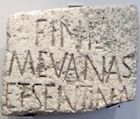
-
“... could relate to either Hispellum or Sentinum [both of which belonged to the Lemonia]: the latter municipium had extra-territorial possessions in the territory of Mevania, as evidenced by a cippus [from an unknown location in Bevagna, now in the Museo Archeologico there] that carries the inscription (CIL XI 5039):
-
Finis/ Mevanas/ et Sentina(s)
-
... I have been able to inspect the inscription, the paleography of which suggests a dating of the middle of the 1st century BC” (my translation).
However, it is not absolutely clear that ‘Sentina(s)’ related to Sentinum. If it did, then it seems to me that, since, according to Cassius Dio, (‘Roman History’, 48: 13: 2-4), Sentinum had revolted against Octavian in 41 BC, he was unlikely to have allowed this rebel city to retain any enclaves of land here after his victory at Perusia. I therefore think (with Zuddas and Spadoni) that the three inscriptions considered in this context by Sisiani probably did all indicate Mevanian territory that had been confiscated and transferred to the colony at Hispellum.
CIL XI 5286
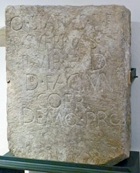
T(itus) Statius T(iti) f(ilius)/ Lem(onia) sevir
The gens Statia is also attested at Spello itself:
-
✴An inscription (AE 1948, 0102, 30BC - 14AD , illustrated here), which was found near Porta Venere t Spello and which is now in Palazzo Bianconi there, records a public project undertaken by the duoviri with the consent of the ordo decurionum (council). The duoviri are named as:
-
•Quintus Statius, son of Publius; and
-
•Publius Safena, son of Titus.
-
✴A now-lost funerary inscription (CIL XI 5340, date ??) from an unknown location in Spello commemorated the freedman Marcus Statius Chilo.
Thus it seems that there was an enclave of the new colony around Fiaggia and that the settlers there included members of gens Statia, a family that was prominent in the public life of the colony.
CIL XI 5118
A now-lost funerary inscription (CIL XI 5118, 27BC - 14AD from Gualdo Cattaneo, some 10 km southwest of Bevagna, read:
Dis manibus/ L. Praecilius L. f. Lem(onia)/ Severus natus Mevaniae
Praeciliae matri kariss(imae) f(ecit)
Enrico Zuddas and Maria Carla Spadoni (referenced below, pp. 61-2) observed that:
-
“Although the inscription is lost, the comparison of the names of the mother and her (natural?) son ... takes us back to the early imperial age” (my translation).
It seems that, although Praecilius had been born in Mevania, he was domiciled at Hispellum (as evidenced by his tribal assignation). By way of comparison, Zuddas and Spadoni drew attention to a veteran of legio XXXXI Augusti Caesaris, who was commemorated in a funerary inscription (CIL XI 4654) from San Valentino, south of Todi [where is it now?], which reads:
C(aius) Edusius Sex(ti) f. Clu(stumina)/ natus Mevaniae
centurio legion(is) XXXXI/ Augusti Caesaris/ et centurio classicus
ex testamento
Thus, the veteran Edusius, who had also been born in Mevania, had apparently received land at the new colony of Tuder (Todi), which had probably been established in ca. 36 BC. Both Edusius and Praecilius would originally belonged to the Aemilia tribe (the tribe of Mevania), but it seems that each of them had subsequently adopted the tribe of the colony in which he had settled: Edusius thus belonged to the Clustumina of Todi; and Praecilius to the Lemonia of Hispellum.
It is, of course, possible that the land at Gualdo Cattaneo on which Praecilius buried his mother had been in his family for some time, and that the land on which Praecilius himself had been settled was closer to Hispellum. However, it is alternatively possible that the land at Gualdo Cattaneo had been confiscated from Mevania for the benefit of the new colony, and that Praecilius (or perhaps his father) had been among the veterans who were settled there.
CIL XI 4907
A now-lost funerary inscription (CIL XI 4907, date ??) from Castel Ritaldi (some 15 km south of Bevagna and 19 km north of Spoleto) read:
... Pomponius T f./ Lem(onia) Ruf(us) ...
Simone Sisani (referenced below, 2012, at p. 433, note 129) suggested that it constituted evidence of land confiscation for veteran settlement in this area. The find spot was on the border of Mevania and Spoletium, so it is not clear which of them had forfeited land for this purpose. However, as Sisani pointed out, other nearby confiscations had been carried out at the expense of Spoletium (as discussed below). We might therefore reasonably assume that this was also the case for the confiscated land evidenced by CIL XI 4907. I therefore discuss this inscription in the section “Spoletium” below.
CIL XI 5275
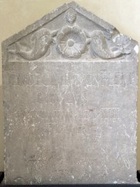
Cn(aeus) Decimius Cn(aei) f(ilius) Lem(onia) Bibulus
evocatus leg(ionis) XIII/ VIvir
Bibulus’ epitaph thus records that he had been:
-
✴an evocatus (a soldier who had served out his time and obtained a discharge but had voluntarily re-enlisted) of legio XIII; and
-
✴a seviri.
Enrico Zuddas and Maria Carla Spadoni (referenced below, at p. 62), following Ferdinando Castagnoli, suggested that Fiamenga was at:
-
“... the point of convergence between the territories of Spello, Bevagna and Foligno” (my translation).
Thus it is not clear whether the land on which Bibulus had been buried had previously belonged to Mevania or to Fulginia (Foligno). However, they pointed out that a later inscription (CIL XI 5033) from Fiamenga commemorated a magistrate from Mevania, which suggests that this city is the more likely candidate.
Asisium (Assisi)
As discussed above, Lawrence Keppie believed (with good reason) that the land that was confiscated from Propertius’ family formed part of the colony that was established at Hispellum in 41 BC. Francis Cairns (referenced below, at p. 53) suggested that some of this land was in the plain below Assisi, in the area around modern Le Viole, Capitan Loreto, Massera and Capodacqua, some 4 km north of Spello:
-
“... where the pertica (centuriated land) of Hispellum intruded deeply into the centuriation of Asisium ...”
He cited the study of the centuriation of the area by Manconi et al. (referenced below, at p. 415), which concluded that:
-
“Rather than an anomaly of centuriation [here], one can speak of the evident intrusion of the orientation of the centuriation of Hispellum into the territory of Asisium” (my translation).
Francis Cairns (referenced below, at pp. 58-9 and notes 91 and 92, following Manconi et al., also referenced below, at p. 405 and pp 416-7) identified two other areas of land in which the original centuriation of Asisium had been superimposed on that of Hispellum:
-
✴an area to the south east of the land identified above; and
-
✴“an even larger area” on the old road from Asisium to Urvinum Hortense, near Tor D’Andrea.
He suggested that this land might have been confiscated from Asisium at the time of the foundation of the colony at Hispellum but subsequently returned to Asisium.
Despite these confiscations, there is no evidence of any interruption of its growing prosperity of Asisium after the Perusine War. However, there were perceptible changes in the fortunes of individual families. In this context, Francis Cairns (referenced below, at p. 13) identified three distinct social trajectories:
-
✴among local families:
-
•the Propertii and the Mimisii, for example, emerge as prominent survivors; while
-
•other leading families such as the Babrii and Voisieni, who feature in the inscriptions from the period before the war, declined or disappeared thereafter, and
-
✴other families who had not apparently featured in the civic life of Asisium before the war, such as the Caesii (mentioned above) and the Petronii, now came to prominence.
Francis Cairns (referenced below, at p. 14, note 68) suggested that the Caesii and the Petronii had been beneficiaries of the confiscations after the Perusine War. However, as discussed below, they might well have arrived in what seems to have been a second wave of veteran settlement about a decade later, which would have involved the purchase rather than the confiscation of land. The putative return to Asisium of land apparently confiscated in 41 BC might also date to this period.
Spoletium (Spoleto)
During the Perusine War (41-40 BC - see the following page), Lucius Munatius Plancus (an ally of Lucius Antonius, albeit a hesitant one) took refuge at Spoletium, but failed to offer any assistance to Lucius Antonius and prudently fled to Greece when Perusia fell to Octavian. Thus, one might expect that Spoletium would be punished by confiscations after the war. Indeed, it was probably at this time that the sanctuary at the source of the river Clitumnus (mentioned above), which had belonged to Spoletium, passed to Hispellum (as discussed further below). However, Emilio Gabba (referenced below, at p. 102) commented that Spoletium seems to have escaped relatively lightly. He suggested two possible reasons:
-
✴Octavian might have been well-disposed towards the city because, as Pliny the Elder recorded (‘Natural History’, 11: 73), he had received favourable omens when he had taken the auspices there immediately after the Senate had recognised his imperium in 43 BC.
-
✴Probably more importantly, Spoletium enjoyed the patronage of Caius Calvisius Sabinus, one of Octavian’s supporters.
Caius Calvisius Sabinus
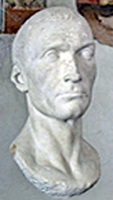
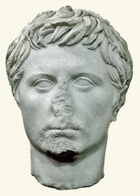
Calvisius Sabinus (?) Octavian
Marble busts from the theatre at Spoletium
According to Ronald Syme (referenced below, 1939, at p. 221 and note 1), Calvisius Sabinus was one of only two senators who tried to protect Julius Caesar from his assassins in 44 BC. Thereafter, he became a supporter of Octavian, under whom he served as consul of 39 BC and as the admiral of Octavian’s fleet in 38-7 BC. Evidence of his association with Spoletium comes from an inscription (CIL XI 4772, 39 BC) that was found at San Martino in Trignano (some 8 km northwest of modern Spoleto) that reads:
Pietati/ [C(ai)] Calvisi C(ai) f(ilii) Sabini
patroni co(n)s(ulis)
VIIvir(i) epul(onum) cur(ionis) max(imi)
It had been inscribed on the base of a statue that almost certainly represented this Sabinus: Ronald Syme (referenced below, 1939, at p. 221 and note 1), who was of this opinion, pointed out that the reference in the inscription to his ‘pietas’ almost certainly refers to his attempt to save Julius Caesar from his fate. The inscription refers to Sabinus as a patron, presumably of Spoletium; Ronald Syme, (referenced below, 1964, at pp 113-4) produced circumstantial evidence from other inscriptions from Herculaneum and Cyzicius that Calvius was a member of the Horatia tribe and thus, in all probability from Spoletium.
The busts illustrated above (both of which are now in the Museo Archeologico, Spoleto) were discovered during the excavation of the Roman theatre there in 1954-60.
-
✴The identity of the person depicted on the left is unknown, but Sabinus would be an excellent candidate.
-
✴The bust on the right depicts Octavian: this bust and similar one at Béziers (now in the Musée Saint-Raymond, Toulouse) are the only known examples of of the so-called ‘Béziers-Spoleto’ group, which Dietrich Boschung (referenced below, at pp. 25-26 and pp. 59-62) dated to 43-40 BC.
The construction of the theatre at Spoletium seems to have begin soon after the middle of the 1st century BC: it is tempting to suggest that Sabinus commissioned both the building of the theatre itself and the bust of Octavian as part of a programme of reconciliation after the Perusine War.
Sanctuary of Clitumnus
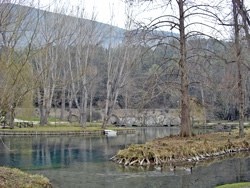
Paolo Camerieri and Dorica Manconi (referenced below, 2010) established the extent of the territory assigned to the colony of Spoletium at the time of its deduction in 241 BC. According to this study, the source of the river Clitumnus (marked Lacus Clitumnus on the plan below) was at the northern edge of the pertica of Spoletium. Pliny the Younger, writing in the 1st century AD, recorded that:
-
“Near [the source of the Clitumnus] stands an ancient and venerable temple, in which is placed the river-god Clitumnus, clothed in the usual robe of state; .... The Hispellates, to whom Augustus [i.e. Octavian] gave this place, furnish a public bath, and likewise entertain all strangers at their own expense” (Letter LXXXVIII to Romanus).
Thus, by Pliny’s time, the important sanctuary of Clitumnus here belonged to Hispellum.
As noted above, John Scheid (referenced below, 2006, at p. 82) saw this as the result of a decision that Octavian had probably taken at the time of the colonisation of Hispellum, when he had also transferred the sanctuary at Villa Fidelia from Mevania to the new colony:
-
“[Octavian also] gave the famous sanctuary at the source of the Clitumnus to the Hispellates. ... In other words, he confiscated this cult site from Spoletium, which had owned it since the deduction of the colony [there in 241 BC]; and perhaps he similarly confiscated a supra-regional sanctuary at Villa Fidelia [from Mevania] to make a [new] colony and an urban centre” (my translation).
Grove Sacred to Jupiter
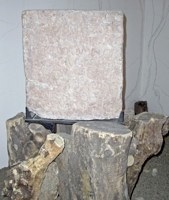
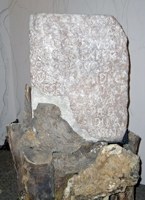
Inscriptions of the so-called lex Spoletina (Museo Archeologico, Spoleto
Two inscriptions (CIL XI 4766, 250 - 175 BC) that record the so-called lex Spoletina indicate the existence of a grove sacred to Jupiter at around the time of the colonisation of Spoletium. Simone Sisani (referenced below, 2007, p. 95) pointed out that they had both been found:
-
“ ... immediately to the west of the Fonti del Clitunno and can indeed be identified as belonging to the sanctuary of Clitumnus, whose identification with Jupiter [recorded by Vibius Sequester] is perfectly consistent with the mention of Jupiter in connection with the [propitiatory fine demanded by the lex Spoletina]” (my translation).
Sisani’s reference to Vibius Sequester refers to an entry in his ‘De fluminibus’ (on rivers), in which he recorded that:
“Clitumnus Umbriae, ubi Iuppiter eodem nomine est”
Clitumnus in Umbria, where Jupiter has the same name
On this basis, we can reasonably assume that this sacred grove had also transferred to the colony of Spoletium soon after its deduction in 241 BC, and that it formed part of the public ‘silva et pascua’ (woods and pasture) that is marked at the northwestern part of the pertica of the colony on the plan below. It is therefore possible that the grove, like the sanctuary, passed from Spoletium to Hispellum in 41 BC.
Land Confiscation at Spoletium
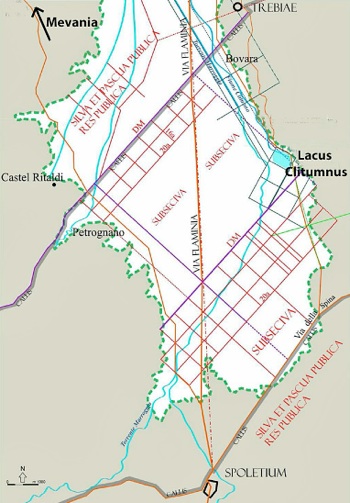
Pertica of Spoletium
Adapted from Camerieri and Manconi (referenced below, 2010, Figure 3)
Paolo Camerieri and Dorica Manconi (referenced below, 2010, at pp. 23-4 and Figure 3) identified an ‘anomalous’ parcel of land slightly to the southeast of the Lacus Clitumnus, the centuriation of which was based on the same allotment size (706 meters) as at Hispellum. This suggests that the transfer of the sanctuary of Clitumnus to Hispellum was accompanied by that of this parcel of newly-centuriated land.
According to Simone Sisani (referenced below, 2012, at p. 433, note 129):
-
“The eventuality of more extensive confiscations here, carried out to provide land for veteran settlement, is suggested by the discovery near Castel Ritaldi of [CIL XI 4907]” my translation).
This now-lost funerary inscription [date ??] read:
...Pomponius T f./ Lem(onia) Ruf(us) ...
As discussed above, the find spot of this inscription was slightly closer to Mevania than to Spoletium. However, given the other confiscations in this part of the pertica of Spoletium discussed above, it seems likely that the land on which Pomponius had been buried had been transferred from Spoletium at the time of the colonisation of Hispellum.
Epigraphic Evidence for a Second Wave of Settlement
As noted above, there is epigraphic evidence for the settlement of veterans at Hispellum who had probably retired only after the Battle of Actium. Two of the three relevant inscriptions record men from legio XIII:
-
✴As discussed above, a funerary inscription (CIL XI 5275, 27 BC - 14 A) from Fiamenga (some 5 km east of Mevania, on Via Flaminia), which is now in the Museo Archeologico at Palazzo Trinci, Foligno, commemorates Cnaeus Decimius Bibulus, an evocatus of legio XIII.
-
✴A second funerary inscription (CIL XI 1933, 30-1 BC) from località Agliano, south of Perugia (discussed below), which is now in the deposit of the Museo Archeologico Nazionale, Perugia, commemorates Caius Allius, a centurion of legio XIII.
Each of these inscriptions is discussed further below: what concerns us here is the history of their legion.
Lawrence Keppie (referenced below, at p. 179) recorded that legio XIII had fought with Julius Caesar in Gaul but that it had been disbanded before the Battle of Philippi (43 BC). The legion had been reestablished by 36 BC, when (according to Appian, ‘Civil Wars’, 5:87) it saved Octavian’s life after a disastrous battle in his war against Sextus Pompeius Keppie pointed out (at p. 179) that men serving in the re-formed legion would not have been discharged before Actium.
-
✴He suggested that:
-
“[Since] Hispellum seems likely to have become a colony after Philippi, Allius and Bibulus could be Caesarian evocati [re-recruited before Philippi, even] though their legion was not apparently re-formed under that numeral,. [However,] the evidence is too slight to form any conclusion.”
-
✴However, Simone Sisani (referenced below, 2012, at p. 436) suggested that the more likely scenario was that both men had fought in the reformed legio XIII and were part of a second wave of veteran settlement at Hispellum after Actium.
Sisani is surely correct: after all, there is nothing to suggest that Allius was an evocatus. The likely scenario is that both men fought with legio XIII at Actium and that they were subsequently settled at Hispellum.
There is perhaps further epigraphic evidence for this putative second wave of settlement in the form of a third (now lost) inscription(CIL XI 5936, 27 BC - 14 AD) from an unknown location at Città di Castello (discussed below), which commemorates Caius Fadius, a centurion of legio XI. Enrico Zuddas and Maria Carla Spadoni (referenced below, p. 60) pointed out that graffiti on slingshots that survive from the Perusine War indicate that legio XI fought in this conflict. However, Fadius is unlikely to have been retired at the end of this conflict, when Octavian needed to keep his legions in tact. Laurence Keppie (referenced below, at p. 77 and p. 79) recorded that veterans of legio XI were settled at Ateste in northeastern Italy after Actium: it is therefore possible that other veterans of the legion could have been settled at Hispellum at this point.
Territory Probably Assigned to Hispellum after Actium
As noted above, Augustus recalled in his biography that he had paid out considerable sums from his own resources for the resettlement of veterans in Italy, probably in 30 BC. We can reasonably assume some of this money was used to purchase land that would be assigned to Hispellum to facilitate the putative second wave of veteran settlement here. In addition, Augustus still had at his disposal land that he had confiscated from Perusia after the Perusine War.
Perusia (Perugia)
Cassius Dio reported that a statue of Juno that had been taken from Perusia to Rome after the fall of the city in 40 BC:
-
“... secured for [Perusia] the privilege of being peopled again by any who desired to settle there, though they did not acquire anything of its territory beyond the first mile”, (’Roman History’, 48:14).
One might therefore expect that much of the territory beyond this first mile was subsequently used for veteran settlement. However, it is unlikely that this took place immediately, since Octavian needed to keep his army in tact at this point. As noted above, the first evidence for veteran settlement on this confiscated land was related to the formation of the Colonia Julia Fida Tuder (at modern Todi, in southern Umbria), which had probably taken place after the Battle of Naulochus (in 36 BC).
There is evidence that other parcels of this Perusine land was used for the extension of the colony at Hispellum after Actium. For example, Gian Luca Gregori (referenced below, 2012, at pp. 118-20) identified two inscriptions in the area of Perusia that commemorated men who had been inscribed in the Lemonia (the tribe of Hispellum):
-
✴As mentioned above, a funerary inscription (CIL XI 1933, 30-1 BC) that was found in 1765 at località Agliano, south of Perugia (now in the deposit of the Museo Archeologico Nazionale, Perugia), commemorates:
-
C(aio) Allio L(uci) f(ilio)/ Lem(onia)/ centurioni/ leg(ionis) XIII
-
We might reasonably assume that, after he retired from legio XIII after Actium (as discussed above), Allius had settled here on land that was assigned to Hispellum.
-
✴A second and much later funerary inscription (CIL XI 1937, 2nd half of the 2nd century AD), which was apparently found a few miles north of Perugia in 1815 (now in the Museo Archeologico Nazionale, Perugia), reads:
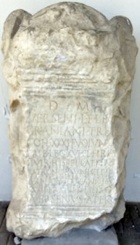
-
D(is) M(anibus)/ [-] Verseni L(uci) f(ili) Leṃ(onia) Graniani
-
tri[b(uni)]/ coh(ortis) XXXII volun[t(ariorum)]
-
trib(uni) leg(ionis) XVI Fl(aviae) Firm(ae)
-
IIvir(i) Hispellatium, patrono municipi/ Arnat(ium);
-
vixit annis/ XXXII, fratri piìssim[o]/ [-] Versenus Aper
-
From this, we learn that Versenus Granianus had been a duovir of Hispellum and a patron of Arna (now Civitella d'Arna, some 10 km east of Perugia - see below):
-
•Versenus Granianus was probably descended from Marcus Granius, one of the earliest duoviri of Hispellum (discussed above).
-
•His brother is recorded as Versenus Aper Hespello (from Hispellum) in another inscription (AE 1997, 1768) that dates to 157 AD.
-
The gens Grania could, of course, have bought land here at any time since they arrived at Hispellum (see above). However, it seems to me to be most likely that this land was granted to the family after Actium, when the confiscated territory outside Perusia began to be assigned to facilitate the second wave of veteran settlement there.
Other instances of veteran settlement on what had been Perusine territory for the expansion of Hispellum after Actium are discussed in the section below on Arna and Vettona.
Perusia itself, which had been effectively destroyed in the fire of 40 BC, was only slowly repopulated. Nevertheless, it survived as a municipium administered by quattuorviri, two of whom are known from inscriptions that both date to some time in the last two decades of the 1st century BC:
-
✴One (AE 1979 246), which is on what was probably the base of a statue, was found in central Perugia in 1915 (and which is now in the Museo Archeologico, Perugia) commemorated Aulus Atilius Glabrio as quattuorvir.
-
✴The second (CIL XI 1934), which is on a cinerary urn that was found in Perugia in the 16th century (now in the deposit of the museum) commemorated Caius Atilius Glabrio, the the son of Aulus and Tettia, as quattuorvir quinquennales.
These men both belonged to the gens Atilia , a family that (as noted above) had moved to Perusia at this time from Campania (the place of origin of the gens Grania). There is no suggestion that they were directly associated with the colony at Hispellum: however, they (or, at least, their family) probably received land at Perusia as viritane settlers, quite possibly in the period after Actium.
Arna and Vettona
According to Lorena Rosi Bonci and Maria Carla Spadoni (referenced below, at p. 206):
-
“Arna [now Civitella d’Arna] and Vettona [Bettona] followed the same path as Perusia: when the latter was ‘restored’ by Augustus and converted into a municipality administered by duoviri [probably in the early 1st century AD], ... [Arna and Vettona were also] instituted as autonomous municipalities that ... received ... duoviri. It must therefore be assumed that, in the previous period, both Vettona and Arna had been administratively dependent on Perusia: such outposts on the left bank of the Tiber [would have given Perusia] full control of the river valley” (my translation).
It seems to me that Perusia is most unlikely to have retained control over either of these centres after the war, albeit that the status of neither of them can be securely established prior to the establishment of the duovirate.
There is surviving epigraphic evidence that some of this previously Perusine territory near Arna and Vettona was subsequently used for the settlement of veterans who had been assigned to Hispellum:
-
✴A now-lost inscription (CIL XI 5291, 30-1 BC ), which was apparently was found in ‘the ruins of ancient Arna’ in the 19th century, read:
fin(es) col(oniae) / Hispell(atis).
-
According to Paola Bonacci and Sabina Guiducci (referenced below, at p. 263), it:
-
“... marked the boundary of the centuriated territory of Arna that had been annexed to the colonia Hispellum” (my translation).
-
(See Manconi et al. referenced below, pp. 411-2 for the anomalous centuriation between Arna and Asisium, which also suggests an enclave owned by Hispellum.)
-
✴Two inscriptions from Vettona itself or its surrounding area commemorate members of the Lemonia tribe of Hispellum:
-
•CIL XI 5195, from an unknown location, which is now embedded in the Palazzo del Podestà, of Bettona, reads:
-
L(ucius) Marius C(ai) f(ilius)/ [Le]monia; and
-
•CIL XI 5551, from Torgiano, which is now in the Monastero di Sant’ Erminio, Perugia, reads:
-
Sex(to) Turṛ[eno?]/ Sex(ti) f(ilio) Lem(onia).
-
According to Enrico Zuddas and Maria Carla Spadoni (referenced below, at p. 61):
-
“For both inscriptions [from Vettona], which are united by:
-
-type [they are funerary inscriptions of similar type];
-
-onomastics [the form used for the names]; and
-
-paleography [the characteristics of the script];
-
and therefore both datable to the end of the first century BC, it can be assumed that the deceased was a veteran [settled on land that now belonged to Hispellum]” (my translation).
It seems to me that Octavian probably assigned this territory, which was still at his disposal, to facilitate the second wave of veteran settlement at Hispellum after Actium.
Tifernum Tiberinum (Città di Castello)
As mentioned above, a now-lost inscription (CIL XI 5936, 27 BC - 14 AD) from an unknown location at Città di Castello read:
C. Fadio C. f./ Lem(onia)/ cent(urioni) leg(ionis) XI
ex test(amento)/ Arbit(ratu) Fadiae C. f./ Paullinae
Enrico Zuddas and Maria Carla Spadoni (referenced below, p. 60) suggested that:
-
“Perhaps [Fadius] was a veteran of Spello who received land [at Tifernum Tiberinum]: indeed the area of Città di Castello has a centuriation that is coeval with that of Hispellum” (my translation).
Paolo Braconi (referenced below, at p. 45) was of the same opinion:
-
“We may wonder whether the colony of Spello had not penetrated ... the fertile plains of the ager Tiferinus. In any event, this territory was separated from that of Hispellum only by the small municipality of Arna. In fact, the territory of Perusia, theoretically [?] situated between Arna and Tifernum Tiberinum, was reduced, in the aftermath of the Perusine War, to a single mile around the city. It follows that the lands placed at the disposal of the triumvirs [at this point] constituted an immense continuum which connected the upper Tiber valley with the Valle Umbra ...” (my translation).
However, as noted above, this colonial enclave was not necessarily formed immediately after the Perusine War: Laurence Keppie (referenced below, at p. 77 and p. 79) recorded that veterans of legio XI settled at Ateste in northeastern Italy after the Battle of Actium, and other veterans of the legion could have been assigned to Hispellum at this point.
Enrico Zuddas and Maria Carla Spadoni (referenced below, p. 60), following Paolo Braconi (referenced below, at pp. 44-7), pointed out that the gens Grania (discussed above) was represented at Tifernum Tiberinum: Marcus Granius Marcellus, the owner of a villa at San Giustino, outside Città di Castello (later the villa of Pliny the Younger), was probably the son of Marcus Granius, the duovir at Hispellum mentioned above. They also pointed out (at p. 61) that:
-
“[The Granii] were not a local family, but came from Campania (Puteoli or Allifae), and had perhaps arrived [in Umbria] only at the time of the deduction of the colony [at Hispellum]. Fadius and his family could have followed the same path, since they were also from Campania (from Allifae)” (my translation).
Fulginia (Foligno)
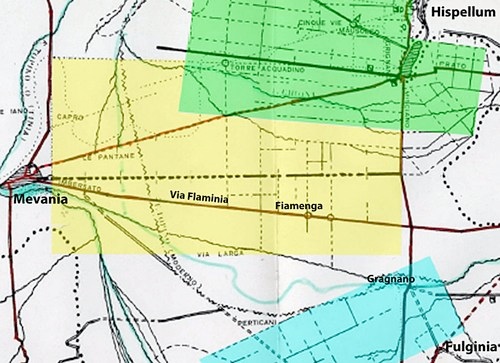
Pertiche of Hispellum, Mevania and Fulginia
Adapted from Manconi et al. (referenced below, 1996), with kind permission of the authors
According to Paolo Braconi (referenced below, at p. 41, following Manconi et al., (referenced below, p. 406, note 102):
-
“The presence of the Granii in Spello [also] left evident traces in local place names: [for example,] a ‘land holding at Gragnano’ was recorded in 1183 near Foligno (ancient Fulginia). In areas subject to colonial assignments, it may be assumed that the rural toponyms ... retained the names of the first holders of [assigned] land. We can reasonably conclude from this that, at the time of the founding of colony at Hispellum and the [consequent restructuring of nearby landholdings], it was a Granius who received the land holding [near Fulginia] that took his name. It seems unlikely that he was a stranger to the Marcus Granius who occupied the office of duovir quinquennalis [at Hispellum soon after colonisation]: indeed, it is very likely that he was the same person or, if not, then at least a member of his family” (my translation).
Manconi et al. (as illustrated above) show Gragnano at the northern edge of the pertica of Fulginia, south of Hispellum and on the opposite side of Via Flaminia
As I mentioned above, a funerary inscription (CIL XI 5275) from Fiamenga on Via Flaminia (marked on the plan above), which is now in the Museo Archeologico at Palazzo Trinci, Foligno, commemorates Cnaeus Decimius Bibulus, an evocatus of legio XIII who had probably been settled at Hispellum after Actium. It is possible that this site was in a corridor of land that was purchased at this time to facilitate part of the second wave of veteran settlement and to connect the urban centre of the colony to the recently-restored Via Flaminia. It is tempting to assume that the Granii acquired their estate near Fulginia at this time.
Summary and Conclusions
In my view, the evidence for a significant expansion of Hispellum after Actium is compelling. The land that had been confiscated from the colony’s immediate neighbours in 41 BC could hardly have supported this expansion, which probably accounts for the creation of many or all of the non-contiguous colonial enclaves described above. Some of this expansion would have been facilitated by the assignation of land previously confiscated from Perusia, but it also seems likely that some of the money that Augustus spent on land for veterans at this time was directed towards the expansion of Hispellum.
The Valle Umbra seems to have become a magnet for settlers from Campania, who followed the lead of Marcus Granius, one of the first duoviri of the new colony. The gens Grania itself acquired land at Fulginia, Perusia and Tifernum Tiberinum. The veteran Caius Fadius, who settled at Tifernum Tiberinum, was also among these immigrants from Campania, as were at least two sets of viritane settlers:
-
✴members of the the gens Caesia at Asisium; and
-
✴members of the the gens Atilia at the slowly-recovering Perusia.
We might also include here the gens Alfia, from Casinum, on the border of Campania and Latium (later the location of the famous monastery of Montecassino), who (as we shall see) achieved social prominence at Hispellum in the Augustan period.
I think that it is highly likely that Augustus financed the expansion of Hispellum, including the building of its walls, which constituted:
-
✴a celebration of his achievement in ending the civil war, thereby opening the way to peace and prosperity; and
-
✴a symbol of his desire to build a ‘home fit for heroes’, for both the earlier settlers and the new ones, who arrived fresh from their victory at Actium.
Hispellum was now probably the most important city in the Valle Umbra, a positions underlined by its ownership of the ancient sanctuary of Clitumnus at the Fonti del Clitunno. Its place at the religious heart of the region would have been confirmed beyond doubt by the monumentalisation of its suburban sanctuary at what is now Villa Fidelia.






















